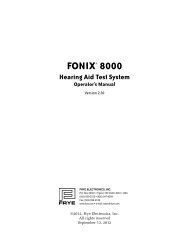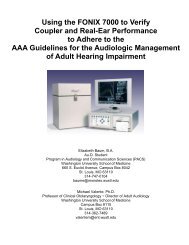FONIX® FP35 Touch - Frye Electronics
FONIX® FP35 Touch - Frye Electronics
FONIX® FP35 Touch - Frye Electronics
Create successful ePaper yourself
Turn your PDF publications into a flip-book with our unique Google optimized e-Paper software.
38 FONIX <strong>FP35</strong> Hearing Aid Analyzer<br />
aids have become more sophisticated and better able to handle loud signals, making<br />
harmonic distortion a more useful measurement at 90 dB SPL. The DIST 90 dB<br />
RULE is still available, but we have turned it OFF by default.<br />
Definitions<br />
• 2ND Harmonic: Energy of the second harmonic or twice the presented frequency.<br />
• 3RD Harmonic: Energy of the third harmonic or three times the presented<br />
frequency.<br />
• TOTAL: Combined 2ND and 3RD harmonic distortion.<br />
2.5.1.3 Noise Reduction<br />
Noise reduction is used in noisy testing environments. Pure-tone noise reduction<br />
takes several measurements at each frequency and averages those measurements<br />
together. Larger noise reduction numbers lead to smoother curves but increase the<br />
amount of time it takes to complete a pure-tone sweep.<br />
For example, if you select “4” as the pure-tone noise reduction setting, 172 measurements<br />
(43 x 4) will be taken with every normal pure-tone sweep<br />
2.5.1.4 Warble Rates<br />
When you take pure-tone measurements in a sound field environment, it is useful<br />
to warble the tones to reduce standing wave effects and create more accurate measurements.<br />
(Warbling is not usually necessary in a sound chamber testing environment.)<br />
The <strong>FP35</strong> analyzer allows you to change the warbling rate of its pure-tone signals.<br />
You do this by altering the WARBLE SOURCE selection in the Custom Menu of<br />
the Coupler Multicurve Screen and the Real-Ear Measurement Screens. The USER<br />
LEVEL must be set to ADVANCED. See Section 2.3.2.<br />
Some types of warbling can cause problems when used to test digital hearing aids.<br />
This is because the digital processing delay of the aid conflicts with the warbling<br />
timing. We have altered our SLOW warble signal to account for this problem. This<br />
type of warbling is automatically selected during real-ear measurements when the<br />
AID TYPE is set to ADAPTIVE in the local menu of the measurement screen.<br />
Here is an explanation of the available warble selections:<br />
• FAST is usually used in real-ear measurements. In all screens except the<br />
Audiogram Entry Screen, it warbles at a rate of 33 Hz. In the Audiogram<br />
Entry Screen, it warbles at a rate of 20 Hz, ±5% deviation from the central<br />
frequency.<br />
• SLOW is used for testing digital hearing aids and for audiometric measurements.<br />
It warbles at a rate of 6.25 Hz, ±5% deviation.
















